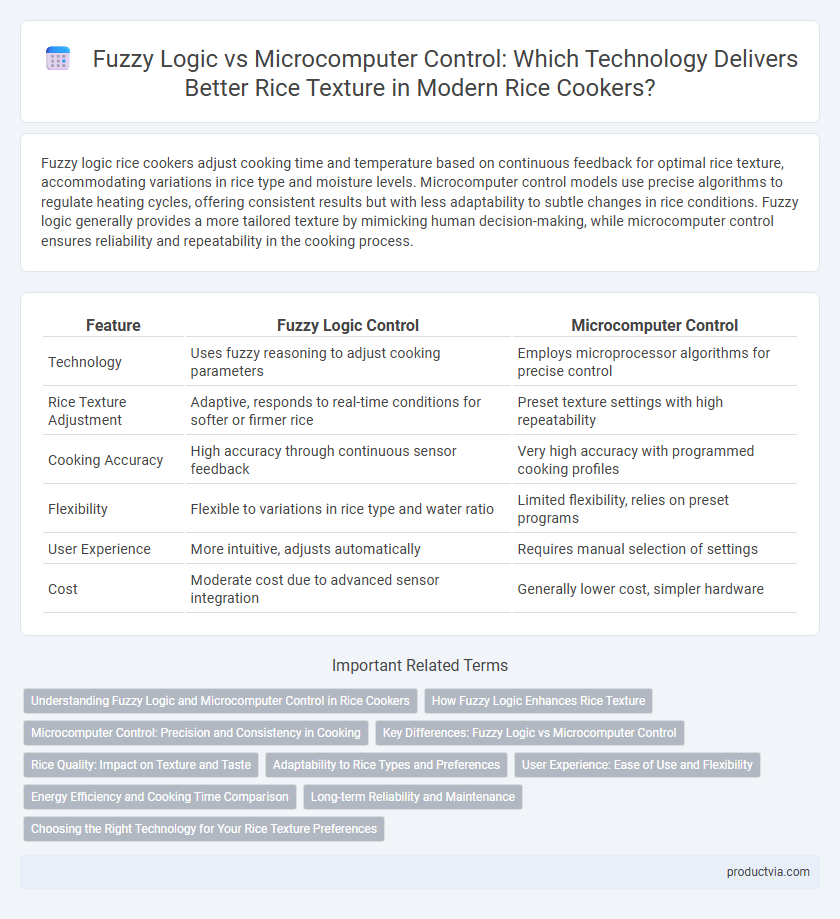Fuzzy logic rice cookers adjust cooking time and temperature based on continuous feedback for optimal rice texture, accommodating variations in rice type and moisture levels. Microcomputer control models use precise algorithms to regulate heating cycles, offering consistent results but with less adaptability to subtle changes in rice conditions. Fuzzy logic generally provides a more tailored texture by mimicking human decision-making, while microcomputer control ensures reliability and repeatability in the cooking process.
Table of Comparison
| Feature | Fuzzy Logic Control | Microcomputer Control |
|---|---|---|
| Technology | Uses fuzzy reasoning to adjust cooking parameters | Employs microprocessor algorithms for precise control |
| Rice Texture Adjustment | Adaptive, responds to real-time conditions for softer or firmer rice | Preset texture settings with high repeatability |
| Cooking Accuracy | High accuracy through continuous sensor feedback | Very high accuracy with programmed cooking profiles |
| Flexibility | Flexible to variations in rice type and water ratio | Limited flexibility, relies on preset programs |
| User Experience | More intuitive, adjusts automatically | Requires manual selection of settings |
| Cost | Moderate cost due to advanced sensor integration | Generally lower cost, simpler hardware |
Understanding Fuzzy Logic and Microcomputer Control in Rice Cookers
Fuzzy logic rice cookers utilize advanced algorithms to mimic human decision-making, adjusting cooking time and temperature dynamically for optimal rice texture by analyzing variables such as moisture and grain type. Microcomputer control systems rely on precise sensors and programmed settings to manage cooking cycles, ensuring consistent results through predefined parameters and real-time adjustments. Understanding the distinction aids consumers in selecting models that balance adaptability and precision tailored to their rice-cooking preferences.
How Fuzzy Logic Enhances Rice Texture
Fuzzy logic technology enhances rice texture by precisely adjusting cooking parameters based on real-time feedback, allowing the rice cooker to adapt to varying grain types and moisture levels. This results in consistently optimal texture, from soft to firm, compared to microcomputer control systems that follow preset programs with limited flexibility. By mimicking human reasoning, fuzzy logic ensures a more customized cooking process, improving taste and overall quality.
Microcomputer Control: Precision and Consistency in Cooking
Microcomputer control in rice cookers offers precise temperature and timing adjustments through digital algorithms, ensuring consistent cooking results and optimal rice texture. Unlike fuzzy logic, which relies on approximate reasoning, microcomputer control uses exact sensor data to fine-tune cooking parameters, reducing variability in each batch. This technology enhances repeatability and allows users to achieve desired rice softness or firmness with reliable precision.
Key Differences: Fuzzy Logic vs Microcomputer Control
Fuzzy logic rice cookers use sensor data to mimic human decision-making, adjusting cooking time and temperature for optimal rice texture with adaptive precision. Microcomputer control relies on pre-programmed algorithms and fixed cooking schedules, offering consistent but less flexible cooking performance. The key difference lies in fuzzy logic's ability to dynamically respond to variations in rice type and moisture, while microcomputer control follows rigid, predetermined settings.
Rice Quality: Impact on Texture and Taste
Fuzzy logic rice cookers adapt cooking time and temperature by interpreting variable moisture and grain characteristics, resulting in consistent rice texture and enhanced taste. Microcomputer-controlled cookers use preset algorithms tuned for specific rice types, providing precise temperature regulation but less flexibility to adjust for variations in rice quality. Fuzzy logic technology generally yields superior texture and flavor by dynamically optimizing cooking parameters throughout the process.
Adaptability to Rice Types and Preferences
Fuzzy logic rice cookers offer superior adaptability by automatically adjusting cooking parameters based on continuous input data, ensuring optimal texture for diverse rice types such as jasmine, basmati, and brown rice. In contrast, microcomputer-controlled models rely on preset programs with limited flexibility, making them less effective in accommodating individual preferences and varying grain characteristics. This advanced adaptability of fuzzy logic technology results in consistently well-cooked rice tailored to specific textures and moisture levels preferred by users.
User Experience: Ease of Use and Flexibility
Fuzzy logic rice cookers adapt cooking times and temperatures based on sensor feedback, delivering consistent, precise rice texture without manual adjustments, enhancing user convenience. Microcomputer-controlled models offer programmable settings and multi-function modes, providing flexibility for diverse cooking preferences and recipes. Users benefit from intuitive interfaces and customizable options, resulting in a tailored cooking experience with minimal effort.
Energy Efficiency and Cooking Time Comparison
Fuzzy logic rice cookers adapt cooking parameters dynamically, optimizing rice texture while reducing energy consumption through precise temperature control. Microcomputer-controlled models utilize programmed cycles to maintain consistent heat, often resulting in slightly longer cooking times and marginally higher energy use. Consumers seeking efficient energy use and faster cooking may prefer fuzzy logic systems for their intelligent adjustments and superior texture outcomes.
Long-term Reliability and Maintenance
Fuzzy logic rice cookers adjust cooking parameters dynamically based on sensor feedback, enhancing rice texture consistency with adaptive control, which can reduce wear over time. Microcomputer-controlled models offer precise timing and temperature regulation but rely on fixed programming, potentially leading to increased maintenance due to mechanical or sensor component fatigue. Over the long term, fuzzy logic systems may provide better reliability and lower maintenance costs by continuously optimizing cooking cycles to prevent overstressing internal parts.
Choosing the Right Technology for Your Rice Texture Preferences
Fuzzy logic rice cookers utilize advanced algorithms that adapt cooking time and temperature based on real-time sensory feedback, delivering consistently optimal rice texture by mimicking human decision-making. Microcomputer control models operate with pre-set programs that automate the cooking process but may lack the nuanced adjustments of fuzzy logic systems. Selecting between these technologies depends on whether you prioritize tailored texture precision or straightforward, reliable preset cooking outcomes.
Fuzzy logic vs microcomputer control for rice texture Infographic

 productvia.com
productvia.com